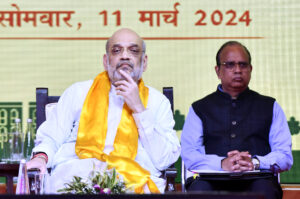Ring of fire in skies today: How, when and where to watch annular solar eclipse in India
[ad_1]
Parts of India will witness an annular solar eclipse on Sunday, wherein the Sun will appear like a “ring of fire”. This is a rare celestial event when the moon comes in between the earth and the sun, leaving the sun’s visible outer edges to form a “ring of fire” or annulus around the moon.
The solar eclipse will be visible from India, Pakistan, China as well as Africa and parts of Europe and Australia. In India, people who are living along the path annular eclipse passing through Anupgarh, Suratgarh, Sirsa, Jakhal, Kurukshetra, Yamunanagar, Dehradun, Tapowan and Joshimath will be able to see the annular phase. However, people living in the rest of India can witness a partial eclipse.
The annular path will also pass through Congo, Sudan, Ethiopia, Yemen, Saudi Arabia, Oman, Pakistan, and China. After its stint in India, it will continue towards China, Taiwan and end in the Pacific Ocean, a press release from Planetary Society, India said on Friday.
An annular solar eclipse happens when it is New Moon — the moon is at a lunar node, so the earth, the moon, and the sun are aligned in a straight line. The moon is near its farthest point from Earth, called apogee, so the outer edge of the sun remains visible as a ring of sunlight.
Solar Eclipse of June 21, 2020: Surya Grahan timings in India
The annular solar eclipse of June 2020 will start at 9:15 am on June 21 as per Indian Standard Timing (IST). The full eclipse will start from 10:17 am with the maximum eclipse occurring at 12:10 pm.
The eclipse starts at one location and ends at another.
First location to see the partial eclipse begin: 09:15:58
First location to see the full eclipse begin: 10:17:45
Maximum Eclipse: 12:10:04
Last location to see the full eclipse end: 14:02:17
Last location to see the partial eclipse end: 15:04:01
State-wise timing:
The annular phase will be visible in the morning from some places within a narrow corridor of northern India — parts of Rajasthan, Haryana and Uttarakhand. A few prominent places within this narrow annularity path are Dehradun, Kurukshetra, Chamoli, Joshimath, Sirsa, Suratgarh.
Solar Eclipse Kolkata timings
Partial Eclipse Begins: Sun, 21 Jun 2020, 10:46
Maximum Eclipse: Sun, 21 Jun 2020, 12:35 0.73 Magnitude
Partial Eclipse Ends: Sun, 21 Jun 2020, 14:17
Duration: 3 hours, 31 minutes
Solar eclipse Delhi timings
Partial Eclipse Begins: Sun, 21 Jun 2020, 10:20
Maximum Eclipse: Sun, 21 Jun 2020, 12:01 0.95 Magnitude
Partial Eclipse Ends: Sun, 21 Jun 2020, 13:48
Duration: 3 hours, 29 minutes
Solar eclipse Mumbai timings
Partial Eclipse Begins: Sun, 21 Jun 2020, 10:00
Maximum Eclipse: Sun, 21 Jun 2020, 11:37 0.70 Magnitude
Partial Eclipse Ends: Sun, 21 Jun 2020, 13:27
Duration: 3 hours, 27 minutes
Solar eclipse Chennai time
Partial Eclipse Begins: Sun, 21 Jun 2020, 10:22
Maximum Eclipse: Sun, 21 Jun 2020, 11:59 0.46 Magnitude
Partial Eclipse Ends: Sun, 21 Jun 2020, 13:41
Duration: 3 hours, 19 minutes
Solar eclipse Bangalore time
Partial Eclipse Begins: Sun, 21 Jun 2020, 10:12
Maximum Eclipse: Sun, 21 Jun 2020, 11:47 0.47 Magnitude
Partial Eclipse Ends: Sun, 21 Jun 2020, 13:31
Duration: 3 hours, 19 minutes
Where to watch:
The Nehru Planetarium in Delhi said that it will webcast the solar eclipse from 10:15 am to 2:00 pm today. People can watch live telecast here.
The Birla Planetarium or other institutions like BITM in Kolkata will remain closed, so people would have to watch the rare event online.

Press release by Nehru Planetarium (nehruplanetarium.org)
The eclipse should not be viewed with the naked eye as it may lead to severe damage to the eye and vision.
Then how should the eclipse be viewed?
Dr Debiprosad Duari, Director, Research and Academic, at the MP Birla Institute of Fundamental Research in MP Birla Planetarium in Kolkata said: “I will request all the sky lovers to observe this but definitely not through naked eyes because observing a solar eclipse is extremely dangerous. Even when it is partial or in an annular face, it can totally destroy your eyesight. So you have to take precautions. number 14 Welder’s glass or aluminized Mylar filter (sun goggles) can be used to look directly at the eclipse,” he said.
“If you do not have that you can make a pinhole in a card sheet and hold it under the Sun. Try to adjust the sunlight through the hole and project it on a wall or a white paper. You can also absorb this phenomenon through a telescope but not with the naked eyes,” Dr Deboprosad pointed out.
ALSO READ: Solar eclipse in India today: Wear goggles, says science and technology ministry
ALSO READ: Some tips for viewing the ‘Ring of Fire’ solar eclipse.
Andhra Pradesh’s Tirupati temple closed
Doors of the Tirumala Tirupati Devasthanams (TTD) in Andhra Pradesh have been closed for devotees ahead of the Solar eclipse which is to be observed on Sunday.
Moreover, to promote global peace and health of entire humanity, the temple will conduct Grahana Japa Yajnam in the Swamy Pushkarini temple tank located at Tirumala on Sunday (June 21).
In this unique Japa Yagnam, the Archakas of Srivari temple, Jeeyangars, Veda Parayanadars and TTD senior officials will participate. As the Grahanam lasts for almost three and a half hours, the sacred programme is divided into six halves.
No Ganga snan
The auspicious Ganga snan will not take place in Varanasi in view of the solar eclipse today, the district administration said.
Also, Ganga aarti, religious procession and congregation will be prohibited as well. Action will be taken against the violation of Section 144 and the Disaster Management Act, the authorities said.
Earth’s doomsday clashes with ‘Ring of Fire’ solar eclipse
Coincidently, the supposed doomsday clashes with the day of Ring of fire — a solar eclipse.
Amidst the ongoing Covid-19 pandemic, multiple tremors of earthquakes, cyclones, potential war, there has been a talk of the world’s ending on Sunday.
The infamous Mayan calendar that predicted the end of the world on December 21, 2020, now suggests that June 21, 2020, can be the final day. Read here to know the basis of the new doomsday
There are between two and five solar eclipses every year, two lunar eclipses have already occurred in January and June. The upcoming solar eclipse is on June 21 is the third eclipse of the year.
The next solar eclipse, which will be a partial solar eclipse, visible from India will take place on October 25, 2022.
(With inputs from Manogya Loiwal, Ashish Pandey, PIB, PTI, timeanddate.com)
[ad_2]
Source link







